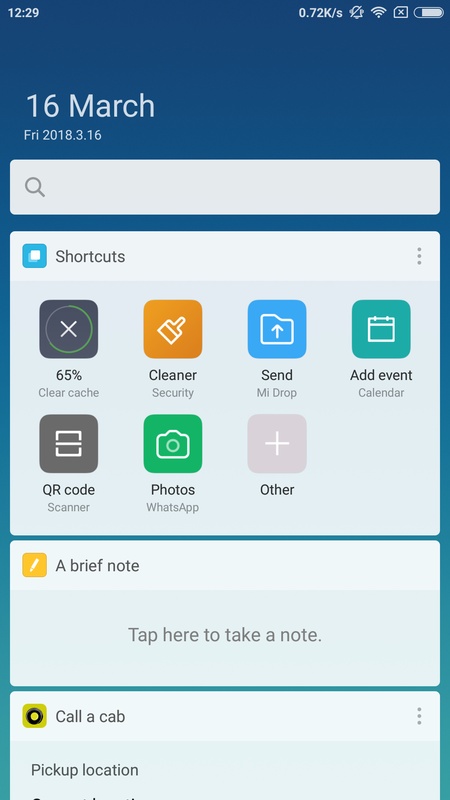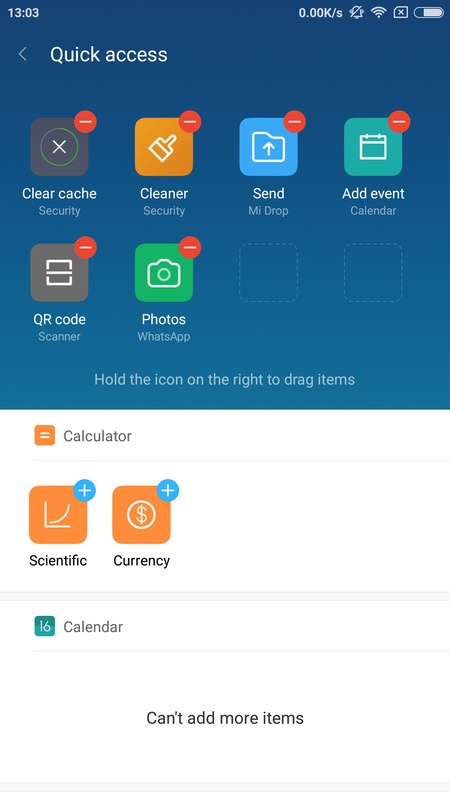Xiaomi App vault is the official Xiaomi app for managing the so-called "cards". This system app is responsible for displaying the contents of the quick access cards offered by Xiaomi devices with the default MIUI launcher. To access it, pinch inward with two fingers on the desktop. Then, click on the settings icon and you will find the option to enable the Xiaomi App vault section.
These cards are customizable, so you can add items, such as apps, system action shortcuts, annotations with the Notes app, or default actions, such as setting a default call to one of your contacts.
Xiaomi App Vault, often pre-installed on Xiaomi devices, serves as a centralized hub offering quick access to frequently used features, information, and applications. Positioned to the left of the primary home screen, it's accessed with a simple right swipe. While offering convenience, its intrusive nature and potential privacy concerns often lead users to seek its disablement.
The App Vault's core functionality revolves around providing quick access to various tools and information. This includes a quick search bar, allowing users to search the web, their device, and apps. It also features shortcuts to frequently used apps, allowing users to bypass navigating through the app drawer. A customizable news feed provides updates on current events, sports, and other topics of interest, while a dedicated section displays upcoming calendar events and reminders. Furthermore, the App Vault integrates with other Xiaomi services, such as Mi Pay for quick payments and Mi Music for music playback controls.
One of the key features of the App Vault is its integration with various system functions. Users can access system settings, such as Wi-Fi and Bluetooth toggles, directly from the App Vault. It also provides quick access to tools like a calculator, flashlight, and screen recorder, eliminating the need to search for these utilities within the device's settings. The integration with Xiaomi's AI assistant allows users to perform voice searches and control smart home devices directly from the App Vault.
However, the App Vault's presence is not without its drawbacks. Many users find its persistent presence intrusive, especially as it occupies a prime screen real estate. The constant stream of information and notifications can be distracting, and some users prefer a cleaner, less cluttered home screen experience. Furthermore, the App Vault's data collection practices have raised privacy concerns among some users, as it collects data on app usage and search queries to personalize the user experience.
Another point of contention is the App Vault's tendency to display advertisements. While these ads are often targeted based on user interests, they can be perceived as intrusive and disruptive. The presence of ads also contributes to the feeling of clutter and can detract from the overall user experience. Despite the potential benefits of quick access and information aggregation, the downsides related to intrusiveness, privacy, and advertisements often outweigh the advantages for many users.
The customization options within the App Vault are somewhat limited. While users can customize the news feed by selecting preferred topics and sources, the overall layout and functionality remain largely fixed. The inability to remove certain sections or rearrange the layout contributes to the feeling of inflexibility and lack of control. Users seeking a more personalized home screen experience may find the App Vault's limited customization options restrictive.
For users who prefer a cleaner home screen experience, disabling the App Vault is a common practice. The process typically involves long-pressing on the home screen, accessing the home screen settings, and toggling off the App Vault option. However, the exact steps may vary slightly depending on the MIUI version and device model. Once disabled, the App Vault is no longer accessible with a right swipe, and the home screen returns to a more traditional layout.
The decision to use or disable the App Vault ultimately depends on individual preferences and priorities. Users who value quick access to information and frequently used features may find the App Vault beneficial. However, users who prioritize a clean and uncluttered home screen experience, or those concerned about privacy and intrusive advertisements, are likely to prefer disabling the App Vault. Ultimately, the choice is a personal one based on individual needs and preferences.
The App Vault's evolution has seen changes in its design and functionality over time. Earlier versions were more basic, offering primarily shortcuts to apps and a simple news feed. Later iterations introduced more advanced features, such as system toggles, integration with Xiaomi services, and personalized recommendations. Despite these changes, the core functionality of providing quick access to information and tools has remained consistent.
The App Vault's future development likely hinges on addressing user concerns regarding privacy and intrusiveness. Improvements in customization options, allowing users greater control over the layout and content displayed, could enhance its appeal. Further integration with other Xiaomi services and the development of new features could also contribute to its evolution. However, striking a balance between functionality and user experience will be crucial for the App Vault's long-term success.
Xiaomi App vault is the official Xiaomi app for managing the so-called "cards". This system app is responsible for displaying the contents of the quick access cards offered by Xiaomi devices with the default MIUI launcher. To access it, pinch inward with two fingers on the desktop. Then, click on the settings icon and you will find the option to enable the Xiaomi App vault section.
These cards are customizable, so you can add items, such as apps, system action shortcuts, annotations with the Notes app, or default actions, such as setting a default call to one of your contacts.
Xiaomi App Vault, often pre-installed on Xiaomi devices, serves as a centralized hub offering quick access to frequently used features, information, and applications. Positioned to the left of the primary home screen, it's accessed with a simple right swipe. While offering convenience, its intrusive nature and potential privacy concerns often lead users to seek its disablement.
The App Vault's core functionality revolves around providing quick access to various tools and information. This includes a quick search bar, allowing users to search the web, their device, and apps. It also features shortcuts to frequently used apps, allowing users to bypass navigating through the app drawer. A customizable news feed provides updates on current events, sports, and other topics of interest, while a dedicated section displays upcoming calendar events and reminders. Furthermore, the App Vault integrates with other Xiaomi services, such as Mi Pay for quick payments and Mi Music for music playback controls.
One of the key features of the App Vault is its integration with various system functions. Users can access system settings, such as Wi-Fi and Bluetooth toggles, directly from the App Vault. It also provides quick access to tools like a calculator, flashlight, and screen recorder, eliminating the need to search for these utilities within the device's settings. The integration with Xiaomi's AI assistant allows users to perform voice searches and control smart home devices directly from the App Vault.
However, the App Vault's presence is not without its drawbacks. Many users find its persistent presence intrusive, especially as it occupies a prime screen real estate. The constant stream of information and notifications can be distracting, and some users prefer a cleaner, less cluttered home screen experience. Furthermore, the App Vault's data collection practices have raised privacy concerns among some users, as it collects data on app usage and search queries to personalize the user experience.
Another point of contention is the App Vault's tendency to display advertisements. While these ads are often targeted based on user interests, they can be perceived as intrusive and disruptive. The presence of ads also contributes to the feeling of clutter and can detract from the overall user experience. Despite the potential benefits of quick access and information aggregation, the downsides related to intrusiveness, privacy, and advertisements often outweigh the advantages for many users.
The customization options within the App Vault are somewhat limited. While users can customize the news feed by selecting preferred topics and sources, the overall layout and functionality remain largely fixed. The inability to remove certain sections or rearrange the layout contributes to the feeling of inflexibility and lack of control. Users seeking a more personalized home screen experience may find the App Vault's limited customization options restrictive.
For users who prefer a cleaner home screen experience, disabling the App Vault is a common practice. The process typically involves long-pressing on the home screen, accessing the home screen settings, and toggling off the App Vault option. However, the exact steps may vary slightly depending on the MIUI version and device model. Once disabled, the App Vault is no longer accessible with a right swipe, and the home screen returns to a more traditional layout.
The decision to use or disable the App Vault ultimately depends on individual preferences and priorities. Users who value quick access to information and frequently used features may find the App Vault beneficial. However, users who prioritize a clean and uncluttered home screen experience, or those concerned about privacy and intrusive advertisements, are likely to prefer disabling the App Vault. Ultimately, the choice is a personal one based on individual needs and preferences.
The App Vault's evolution has seen changes in its design and functionality over time. Earlier versions were more basic, offering primarily shortcuts to apps and a simple news feed. Later iterations introduced more advanced features, such as system toggles, integration with Xiaomi services, and personalized recommendations. Despite these changes, the core functionality of providing quick access to information and tools has remained consistent.
The App Vault's future development likely hinges on addressing user concerns regarding privacy and intrusiveness. Improvements in customization options, allowing users greater control over the layout and content displayed, could enhance its appeal. Further integration with other Xiaomi services and the development of new features could also contribute to its evolution. However, striking a balance between functionality and user experience will be crucial for the App Vault's long-term success.










